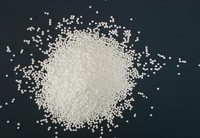Sodium Benzoate
Specifications
Sodium benzoate has the chemical formula NaC7H5O2; it is a widely used food preservative, with E number E211. It is the sodium salt of benzoic acid and exists in this form when dissolved in water. It can be produced by reacting sodium hydroxide with benzoic acid. Benzoic acid occurs naturally at low levels in cranberries, prunes, greengage plums, cinnamon, ripe cloves, and apples.
I. Descriptions of Commodity:
Sodium Benzoate
Molecular Formula: C7H5NaO2
Molecular weight: 144
Executive standard: GB1902-2005, BP 98
Type: food, industrial and medical grade
Appearance : White particles or crystal powder
II.Specifications of goods:
| Item | Standard | Result |
| Characteristics | White Powder | White Powder |
| Identifications | Qualfied | Qualfied |
| Acidity or alkalinity | 0.20 | <0.20 |
| Assay | 99.0%~100.5% | 99.50% |
| Heavy metals(Pb) | 0.001% | <0.001% |
| Ionic chloride | 0.02% | <0.02 |
| Total chlocine | 0.03% | <0.03 |
| Loss on drying | 2.0% | 1.13% |
| Clarity and colour of solution | Qualified | Qualified |
| Conclusion: | The product above complies with the BP-98. |
III.Applications:
1)As an excellent food preservative, can be used as the antiseptic sterilization of various food and beverage;
2)As antiseptic sterilization of various drugs in pharmaceutical industry;
3)It can be used in the production of metal’s corrosion inhibitor and antioxidant;
4)Also used in plastic industry,paint and feed industry.
Preservative
Sodium benzoate is a preservative. As a food additive, sodium benzoate has the E number E211. It is bacteriostatic and fungistatic under acidic conditions. It is most widely used in acidic foods such as salad dressings (vinegar), carbonated drinks (carbonic acid), jams and fruit juices (citric acid), pickles (vinegar), and condiments. It is also used as a preservative in medicines and cosmetics. Concentration as a preservative is limited by the FDA in the U.S. to 0.1% by weight. Sodium benzoate is also allowed as an animal food additive at up to 0.1%, according to AFCO's official publication.
Mechanism of food preservation
The mechanism starts with the absorption of benzoic acid into the cell. If the intracellular pH falls to 5 or lower, the anaerobic fermentation of glucose through phosphofructokinase decreases sharply which inhibits the growth and survival of microorganisms that cause food spoilage.
- Country: China (Mainland)
- Founded Year: 1976
- Address: Xinji City Hebei Province China
- Contact: Liu Bill










